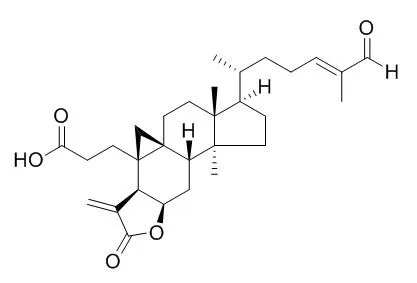| In vitro: |
| Int J Microbiol. 2014;2014:410935. | | Antibacterial Activities and In Vitro Anti-Inflammatory (Membrane Stability) Properties of Methanolic Extracts of Gardenia coronaria Leaves.[Pubmed: 24695677] |
METHODS AND RESULTS:
This work is carried out with Gardenia coronaria leaves that belong to the family Rubiaceae, which is a small-to-medium-sized but tall, deciduous tree, 7.6-9 m high on an average. Leaves are used for the treatment of rheumatic pain and bronchitis. The leaf of the plant consists of Coronalolide, coronalolic acid, Coronalolide methyl ester, ethyl coronalolate acetate triterpenes (secocycloartanes), and so forth. Methanol extract from the leaves of Gardenia coronaria was completely screened for membrane stability and antibacterial activity. The lower concentrations of Methanolic leaf extract of Gardenia coronaria gave good antimicrobial and anti-inflammatory activity, but higher concentrations gave relatively more projecting antibacterial activity in vitro as compared with Kanamycin. The crude drug's anti-inflammatory effects were compared with those of Aspirin as positive control.
CONCLUSIONS:
The Methanolic extracts of Gardenia coronaria leaves possessed a broad spectrum antibacterial activity against a variety of both Gram-negative and Gram-positive organisms like Streptococcus agalactiae, Escherichia coli, Pseudomonas aeruginosa, Bacillus cereus, Shigella sonnei, Shigella boydii, and Proteus mirabilis, with a zone of inhibition from 10 to 16 mm. The extract also showed good membrane stability to be considered as having significant anti-inflammatory action. | | Tetrahedron,2004, 60(7):1517-23. | | Cytotoxic and anti-HIV-1 constituents from leaves and twigs of Gardenia tubifera[Reference: WebLink] |
METHODS AND RESULTS:
Two new natural cycloartanes, tubiferolide methyl ester (1) and tubiferaoctanolide (2), together with the known Coronalolide (3) and Coronalolide methyl ester (4) have been isolated from leaves and twigs of Gardenia tubifera. In addition, a new flavone 5,3',5'-tri-hydroxy-7,4'-dimethoxyflavone (5), five known flavones 6-10 and hexacosyl 4'-hydroxy-trans-cinnamate (11) were also obtained from the same source. The structures were assigned on the basis of spectroscopic methods.
CONCLUSIONS:
Compounds 3, 7, 9, and 10 showed significant cytotoxic activities only in P-388 cell line. Compound 1 was cytotoxic against P-388, KB, Col-2 and Lu-1, while 4 was active in P-388 and BCA-1. Compounds 3 and 4 displayed significant anti-HIV activities in the HIV-1RT assay; compound 7 showed moderate activity in this assay. Compounds 5-10 were also found to be active in the ΔTat/RevMC 99 syncytium assay. |
|






 Cell. 2018 Jan 11;172(1-2):249-261.e12. doi: 10.1016/j.cell.2017.12.019.IF=36.216(2019)
Cell. 2018 Jan 11;172(1-2):249-261.e12. doi: 10.1016/j.cell.2017.12.019.IF=36.216(2019) Cell Metab. 2020 Mar 3;31(3):534-548.e5. doi: 10.1016/j.cmet.2020.01.002.IF=22.415(2019)
Cell Metab. 2020 Mar 3;31(3):534-548.e5. doi: 10.1016/j.cmet.2020.01.002.IF=22.415(2019) Mol Cell. 2017 Nov 16;68(4):673-685.e6. doi: 10.1016/j.molcel.2017.10.022.IF=14.548(2019)
Mol Cell. 2017 Nov 16;68(4):673-685.e6. doi: 10.1016/j.molcel.2017.10.022.IF=14.548(2019)